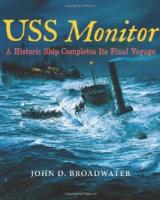 On December 31, 1862 while under tow in a gale off Cape Hatteras, USS Monitor sank. The Monitor had been in service for only ten months and yet in that brief time had revolutionized naval warfare. The wreck of the Monitor was finally located in August of 1973. In his book, USS Monitor – A Historic Ship Completes Its Final Voyage, John Broadwater tells the remarkable story of the ship and of the dedicated teams of archeologists, historians, divers and engineers who worked over the last forty years to preserve the ship and to rescue what could be saved from the wreck.
On December 31, 1862 while under tow in a gale off Cape Hatteras, USS Monitor sank. The Monitor had been in service for only ten months and yet in that brief time had revolutionized naval warfare. The wreck of the Monitor was finally located in August of 1973. In his book, USS Monitor – A Historic Ship Completes Its Final Voyage, John Broadwater tells the remarkable story of the ship and of the dedicated teams of archeologists, historians, divers and engineers who worked over the last forty years to preserve the ship and to rescue what could be saved from the wreck.
Broadwater is uniquely qualified to tell the story of the “ship that changed everything.” He was the only person involved in the Monitor from the discovery of the wreck in 1973 through preservation, management and the recovery of the portions of the ship being preserved ashore today. He recently retired from the National Oceanographic and Atmospheric Administration’s Office of National Marine Sanctuaries, where he served as chief archaeologist.
It is difficult to overstate the importance of the USS Monitor. The Federal Navy had nothing that would be able to stop the Confederate ironclad, CSS Virginia, built from the hull and machinery of the ex-steam frigate, USS Merrimack. Only the genius of the Swedish engineer and inventor John Ericson, who delivered the radical USS Monitor in just over 100 days, stopped the Confederate monster. The battle between USS Monitor and CSS Virginia ended in a draw, and yet the four hour slugging match between the two ironclads on March 9, 1861, made all the wooden navies in the world instantly obsolete.
USS Monitor – A Historic Ship Completes Its Final Voyage tells the story of the revolutionary ship, from its conception, to its preservation over 150 years later. The account is big, sweeping and complex – part history, part mystery, and part high adventure, as well as being a major engineering and organizational puzzle to be solved.
Broadwater does a fine job in presenting the story in manageable portions without overwhelming the reader. Initially, the book alternates between the history of the ship in 1861 and the discovery of the wreck site in 1973. Then, the book settles into an alternating pattern of descriptions of the planning and organizing for each major dive season, followed by fascinating and often harrowing descriptions of the challenges of diving on the wreck, 240 feet underwater, off the treacherous Cape Hatteras coast.
Impressively, both sides of the story are fascinating. John Broadwater was one of the three archeologists to conduct the first excavation of Monitor‘s hull in 1979. In 1992, he was selected manager of the Monitor National Marine Sanctuary, the federal marine preserve that protects and manages the wreck. The national marine sanctuary set aside to protect the Monitor was, like the ship, the first of its kind.
In the best of all worlds, Broadwater and his team would have found themselves with an ample budget and all the resources required to preserve this national treasure. Instead, they found themselves with limited funds and had to work to build alliances and partnerships with state, local and federal agencies, as well as with private research divers and maritime non-profits, to get the resources they needed to protect and preserve the historic wreck. Fortunately, in 1997 the Navy decided that the Monitor wreck would be an excellent place to train their salvage divers and committed the Mobile Diving and Salvage Unit TWO (MDSU TWO) to the project. MDSU TWO would play an critical role in the some of the most difficult tasks during the recovery.
If the political and bureaucratic situation ashore was challenging, the conditions at the wreck site were dreadful. Bad weather and high seas on the surface and strong currents and poor visibility meant that in many cases, three days on site meant only one day of diving.
The engineering problems were equally daunting. The Monitor had capsized as it sank and the gun turret and the machinery were both underneath the fragile ship’s hull. The planning and engineering to remove and lift these critical components is fascinating and the actual extraction of the turret and machinery makes for a gripping read.
Once the turret was ashore, high tech forensics were brought to bear to recover artifacts and to identify the remains of two sailors trapped in the turret when the ship sank.
The book is beautifully illustrated, and replete with photographs and interesting sidebars, detailing various aspects of the history, discovery and preservation of the ship. USS Monitor – A Historic Ship Completes Its Final Voyage is a fascinating story, well told, of a ship that changed history and of those who worked long and diligently to preserve her. Highly recommended.

Pingback: USS Monitor, revolutionair oorlogsschip | Bootjesgek.nl